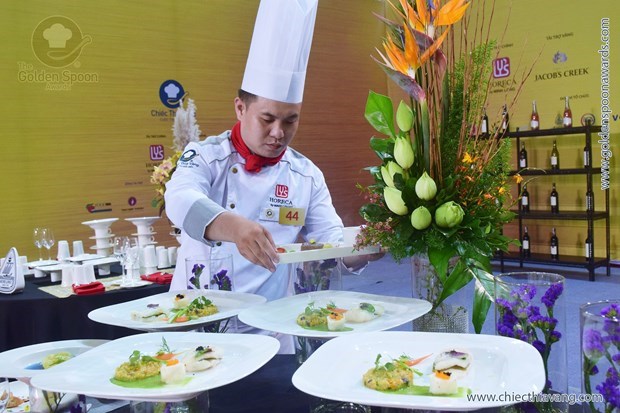
Lead of team 44 – chef Nguyen Huynh Dang Tuyen was precisely decorating his party table in The Golden Spoon 2016 semi-final round.
1. Once again, this was the 3rd
time that chef Nguyen Huynh Dang Tuyen led his team to final top 15 of The
Golden Spoon contest. Their achievements this year were even more impressive
with the food story and determination of 28 years old chef Nguyen Huynh Dang
Tuyen and his colleagues – chef Le Quoc Cuong and Le Quoc Tuan. They performed
a significant menu, which carried their final results of finding, researching,
and combining specialties from all over the country. Moreover, those young
chefs progressively applied modern cooking techniques, which sous vide was am
example. Elite Artist Kim Xuan delicately noticed “I’ve seen hi-tech equipment on all kitchen shelves but among of all,
I’m kinda’ notice the very big machine of team 44, which you guys call it…
what? To sous vide “rabbit fish”. You also have a handmade wooden tool to pull
sugar-strings. Not just talented, but you guys also put lots of effort in
researching and inventing new suitable cooking tools.”
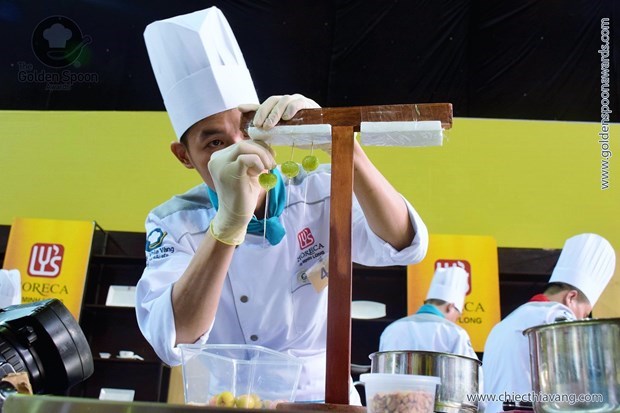
Chef Le Quoc Tuan highly focus on pulling crystalized sugar strings to garnish his dessert on handmade shell.
Chef Dang Tuyen told us that the
whole team had been researching a lot about slow-cooking method because this
was the best way to preserve nutrition of ingredients. However, a sous vide pot
might cost over 10,000,000vnd so that chef Dang Tuyen found a way to create his
own slow-cooking pot after 2 months trying.
In semi-final round, their dishes
were much more diverse than in preliminary, covering the whole length of
Vietnam from mountains to oceans’ specialties. Nonetheless, southwestern
flavors have still played an important role in featured ingredients and spices,
which were hand picked by chef Dang Tuyen. Journeys along the coast have
cultivated the mind and knowledge of chef Dang Tuyen, helping him to learn more
about values of countryside’s products.
This semi-final round was a good
opportunity to show his feats. Judge Kim Xuan mentioned their displayed spices
“… is not as abundant as other teams but I saw modern techniques used through
cooking process. Ingenuity and professional! You guys have well preserved your
ingredients, all were kept in the fridge until their turn.” Team 44’s menu of
The Golden Dishes at southern semi-final included Grilled beef rolled cassava
and Cat Loi leaves, Salad melon and Ca Xiu (a salt-water small snails in Ha
Tien coastal area), Deep-fried spring rolls stuffed small shrimps and water
lily root, Sous vide seaweed rolled rabbit fish served with quinoa and
vegetable in lemon basil sauce, and Macadamia cake with Doi seeds served with
hibiscus flower tea.
2. The appetizer included 3 dishes in
which grilled beef rolled cassava and Cat Loi leaves was a great creation,
inspired by Banh Xeo (rice flour pancake) and Cat Loi – a southern feature
plant. According to medical articles, Cat Loi (Costus speciosus) has several
casual names and it is often served in southern Banh Xeo. It is not only a
sweet edible leaf but also an herb, which people believe it can reduce arthritis,
back pain, neuralgia, fever and anti-inflammatory. The process was as following:
- Grate cassava, mix them with
tapioca flour, well-knead to make fine dough
- Marinate Cu Chi beef with garlic
and soy sauce, sauté then slice into bites
- Roll sautéed beef and Cat Loi
tips in cassava dough
Chef Dang Tuyen said that recently,
sunlight had been really tense in Middle Highlands so that Cat Loi had bloomed
and he had to find Cat Loi leaves from Ben Tre province.
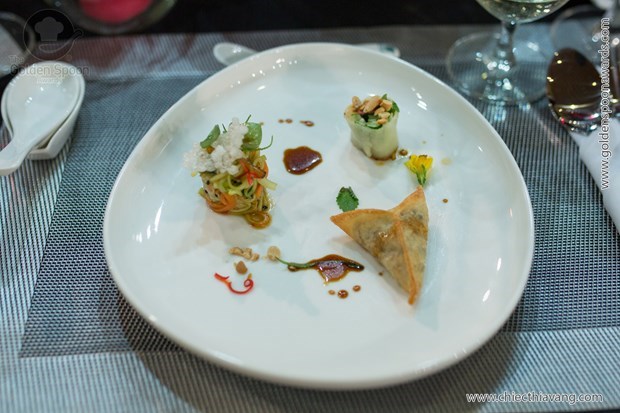
Grilled beaf rolled cassava and Cat Loi leaves, Salad melon and Ca Xiu, Deep-fried spring rolls stuffed small shrimps and water lily root - served with coconut flower honey sauce.
Salad
melon and Ca Xiu was a national “marriage” between Middle and Southern
specialties. This melon is a common type growing around Hue city that people
prefer to eat them raw, or to pickle them; Ca Xiu is a special Mam (fermented
fish or seafood) of Ha Tien coastal area (Kien Giang province). They added
shred skin-off pork belly and chopped Ram leaves (Persicaria odorata) to enrich
the salad then served it with roasted peanut and white sesame.
Meanwhile,
fried rolls are path to Ben Tre province. Chefs chose young water lily roots,
which is waxy and sweet, while old ones is fibrous. Water lily roots was boiled
and smashed; Small shrimps were peeled, taken heads off then lightly smashed;
Black fungus and pork paste were added into water lily root and shrimps batter.
All of ingredients would be rolled in Pia shells (hundreds layers shells) then
deep-fried.
These
rolls were served with the same coconut flower honey sauce. Coconut flower
honey has strong aroma with sour aftertaste, and caramel color. Chefs thickened
honey with fish sauce and hot pepper to create a unique sauce.
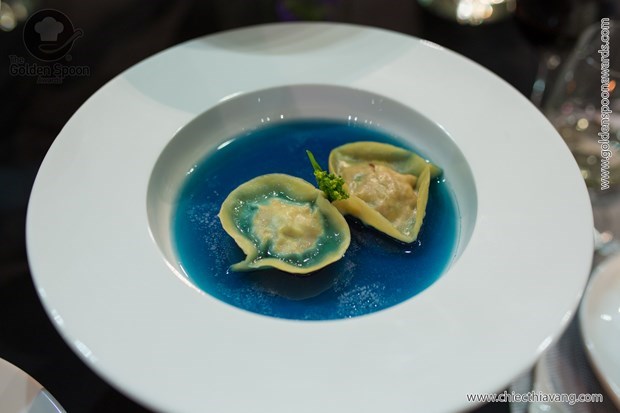
Squad wontons and butterfly pea flowers soup.
Squad
wontons and butterfly pea flowers soup was a beautiful creation in which the
transparent blue broth was chef Dang Tuyen’s discover from the Internet. Squads
were cleaned, taken bones out then finely chopped with white fungus, welsh
onions, and seasonings. Squad paste was divided into pieces, wrapped in wonton
sheets and shaped like a shell. The broth was made from chicken breast, pork
loin, ribs without fat, and pears to make a transparent sweet soup. Butterfly
pea flowers were steeped into this boiling broth.
Those
flowers were from chef Dang Tuyen’s house. He read on the Internet about usages
of butterfly pea, such as Malaysian uses it as natural food color to dye sweet
rice, Thai uses it to color a drink named Nam Dok Anchan, and other country
have used it to color flour.
Waiting
for butterfly pea flowers doing their job, squad wontons were blanched until
cooked. “We don’t cook wontons in broth
pot to avoid flour from wonton contaminating the broth’s transparency. When
everything was ready, wonton would be place in small bowl, broth would be
poured in, and added some spoons of butterfly pea flower broth. The unique
characteristics are not only the sweet taste of squad but also the color of
broth. I just wondered why Cam leaves – a natural purple food color – have been
widely used, so why not butterfly pea?” said chef Dang Tuyen

Sous vide rabbit fish rolled seaweed, served with quinoa, vegetable, and lemon basil sauce.
3. This dish was a real feat, in both
finding ingredients and processing. Rabbit fish (or rabbit-face fish) is
originally from Ly Son area. Chef Dang Tuyen swallowed a big pity when he could
not get rabbit fish’s skin since fishermen immediately skinned off and sold to
pharmaceutical companies. People said that rabbit fish’s skin is to produce medical
sutures so its price on Ly Son Island is about $2000 per kg. Lead of team 44
affirmed that rabbit fish was a unique specialty, which has numerous ways to
cook like to grill, to steam, to roast with salt, and to make congee. This fish
has big bones so it’s easy to process. Fillet fish was marinated with salt and
vegetable oil, placed in special vacuumed bag with seaweed, layer by layer then
sous vide in 60 minutes at 500oC.
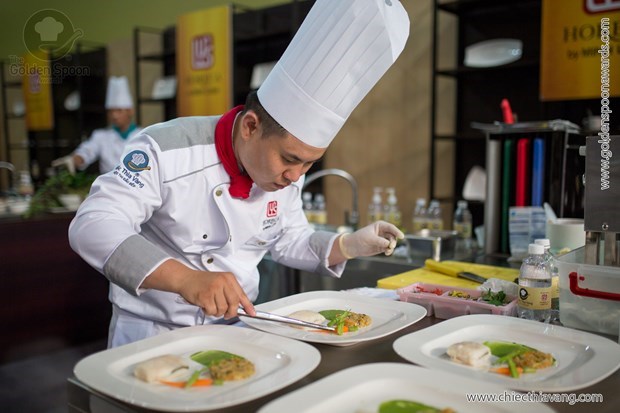
Chef Dang Tuyen was displaying rabbit fish on the dish.
Chef
Dang Tuyen was asked why they had to cook this fish in 60 minutes and he
answered “This fish has chewy and
muscular flesh, even more than chicken. Its elasticity is much higher than
other fish so that we have to sous vide it slower than sous vide cod or salmon.” After sous vide-ing process, rabbit fish was ready but chef Dang Tuyen
wanted to beautify the final product by sauté-ing
both sides of the fillets to golden brown.
Australian
quinoa grains are considered as super-food in future because they contain high
nutrition and vital Amino acids. Chefs added pumpkin, asparagus, zucchini, and
some seasonings (black pepper salt and fish sauce) to quinoa and cooked the
whole thing as cooking rice.
Rabbit
fish was served with lemon basil sauce to deodorize fishy taste. Rabbit fish
bones, ginger, welsh onions, and garlic were stewed until mushy, then grinded
and filter it our to get pure broth. Lemon basil was quickly blanched then
steeped in ice water to keep its greenish. The fish broth and lemon basil juice
were thicken to complete an amazing sauce.
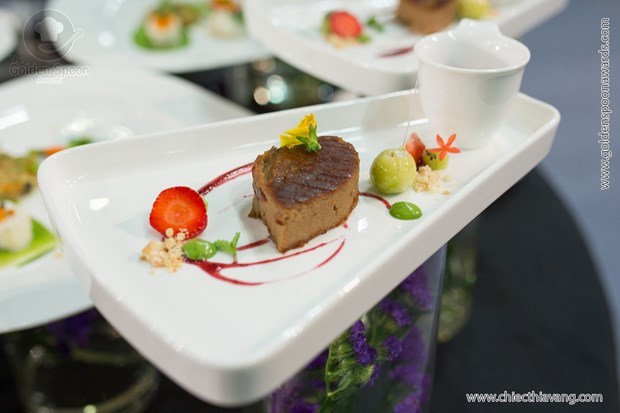
Macadamia with Doi seed cake, served with hibiscus tea.
4. Last round, chef Dang Tuyen had
wanted to make this dessert but the team had got some problems with
transportation. Therefore, it would appear in semi-final round. This cake was
inspired by traditional Gan cake (a
typical southwest cake make from duck eggs) with heirloom recipe from chef Dang
Tuyen family. The batter was from eggs, milk, macadamia, and Doi seeds to make
an impressively nutty and buttery dessert. Meanwhile, dessert tea was prepared
at least a month ago by roasting sun-dried hibiscus, green tea leaves and
jasmine flowers then brewed in 30 days.
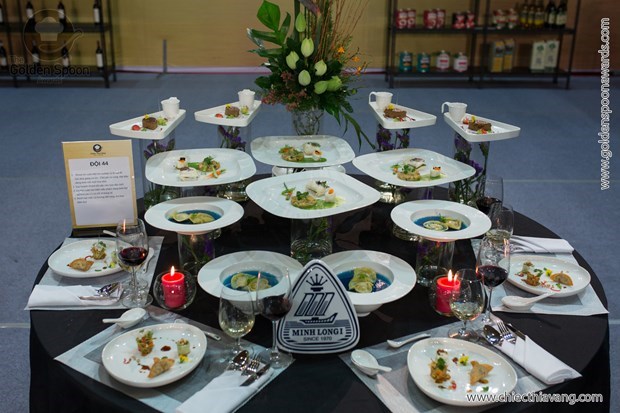
Team 44’s party table in southern semi-final round.
Judge
Kim Xuan gave lots of compliments to team 44 “Appetizers are very tasty in which the salad was my first time to
taste. Shrimps are well seasoned and soup is a beautiful harmony. I specially
love rabbit fish. I can tell you guys invested so much into this dish. Dessert
is very interesting, too.” However, judge Kim Xuan thought that if they had
used some real butterfly pea flowers to decorate their party table, it would be
more impressive and would pleased all diners.
By Nguyen Trang